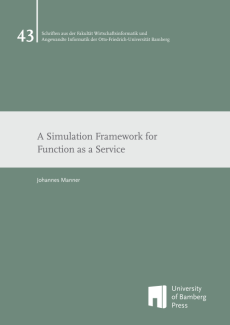Johannes Manner
A Simulation Framework for Function as a Service
Reihe: Schriften aus der Fakultät Wirtschaftsinformatik und Angewandte Informatik der Otto-Friedrich-Universität BambergServerless Computing is seen as a game changer in operating large-scale applications. While practitioners and researches often use this term, the concept they actually want to refer to is Function as a Service (FaaS). In this new service model, a user deploys only single functions to cloud platforms where the cloud provider deals with all operational concerns – this creates the notion of server-less computing for the user.
Nonetheless, a few configurations for the cloud function are necessary for most commercial FaaS platforms as they influence the resource assignments like CPU time and memory. Due to these options, there is still an abstracted perception of servers for the FaaS user. The resource assignment and the different strategies to scale resources for public cloud offerings and on-premise hosted open-source platforms determine the runtime characteristics of cloud functions and are in the focus of this work. Compared to cloud offerings like Platform as a Service, two out of the five cloud computing characteristics improved. These two are rapid elasticity and measured service. FaaS is the first computational cloud model to scale functions only on demand. Due to an independent scaling and a strong isolation via virtualized environments, functions can be considered independent of other cloud functions. Therefore, noisy neighbor problems do not occur. The second characteristic, measured service, targets billing. FaaS platforms measure execution time on a millisecond basis and bill users accordingly based on the function configuration. This leads to new performance and cost trade-offs.
Therefore, this thesis proposes a simulation approach to investigate this tradeoff in an early development phase. The alternative would be to deploy functions with varying configurations, analyze the execution data from several FaaS platforms and adjust the configuration. However, this alternative is time-consuming, tedious and costly. To provide a proper simulation, the development and production environment should be as similar as possible. This similarity is also known as dev-prod parity. Based on a new methodology to compare different virtualized environments, users of our simulation framework are able to execute functions on their machines and investigate the runtime characteristics for different function configurations at several cloud platforms without running their functions on the cloud platform at all. A visualization of the local simulations guide the user to choose an appropriate function configuration to resolve the mentioned trade-off dependent on their requirements.

